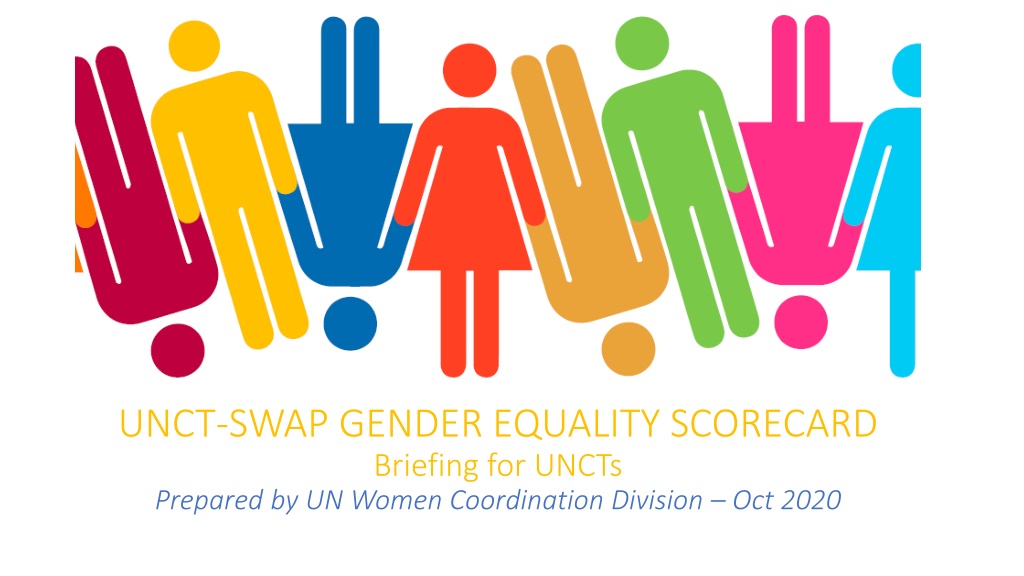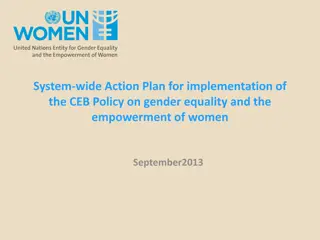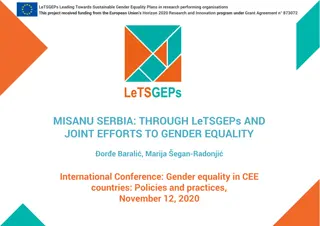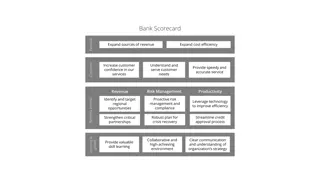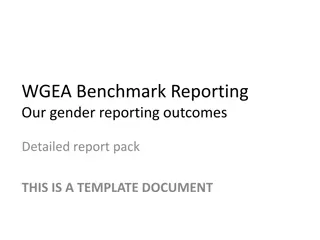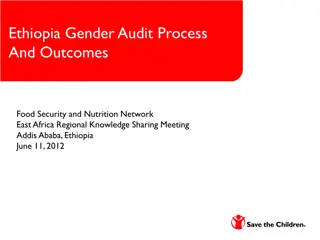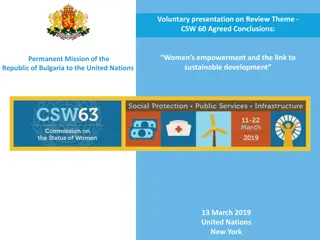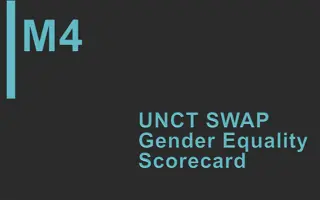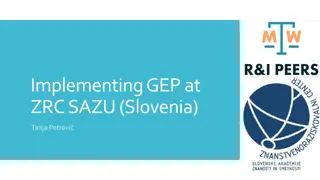Understanding UNCT-SWAP Gender Equality Scorecard
The UNCT-SWAP Gender Equality Scorecard is an accountability framework aimed at enhancing planning, coordination, programming, and results for gender equality and women's empowerment at the country level. It evaluates the UN system's performance in gender mainstreaming based on global minimum requirements set by the UNSDG. Developed through various stages since 2006, it aligns with the 2030 Agenda and SDGs, emphasizing gender equality integral to development efforts. A comparison to UN-SWAP 2.0 highlights similarities and differences in focus areas and processes between corporate and country levels.
Download Presentation

Please find below an Image/Link to download the presentation.
The content on the website is provided AS IS for your information and personal use only. It may not be sold, licensed, or shared on other websites without obtaining consent from the author. Download presentation by click this link. If you encounter any issues during the download, it is possible that the publisher has removed the file from their server.
E N D
Presentation Transcript
UNCT-SWAP GENDER EQUALITY SCORECARD Briefing for UNCTs Prepared by UN Women Coordination Division Oct 2020
What is the UNCT-SWAP Gender Equality Scorecard? An accountability framework that promotes improved planning, coordination, programming and results for gender equality and women s empowerment at the country level. Assesses the performance of the UN system for gender mainstreaming against global minimum requirements established by the UNSDG. Does not measure individual agency performance.
How was the Scorecard developed? 2006 2008 2012 2016-17 June 2018 2019 UNSDCF Internal Guidance - integrating UNCT-SWAP Piloting and development of annual reporting guidance CEB Policy on gender equality and women s empowerment UNDG endorsed the Gender Scorecard UNDG endorsed the UN-SWAP (Systemwide Action Plan for Gender Equality and the Empowerment of Women) Piloting and development of new versions of UN-SWAP and UNCT-SWAP Scorecard Updated UNCT-SWAP Gender Equality Scorecard Technical Guidance endorsed
Linkages to UNSCDF Guidance Gender equality and women s empowerment are integral to realizing the 2030 Agenda and all of the SDGs. To integrate a focus on these issues throughout the Cooperation Framework, UN development entities should put gender equality at the heart of programming, driving the active and meaningful participation of both women and men, and consistently empowering women and girls, in line with the minimum requirements agreed upon by the United Nations Sustainable Development Group (UNSDG) in the UNCT System-wide Action Plan (SWAP) Gender Equality Scorecard. UNSDG (2019). United Nations Sustainable Development Cooperation Framework Internal Guidance (page 11, para 20).
UN-SWAP 2.0 & UNCT-SWAP GE SCORECARD HOW DO THEY COMPARE? SIMILARITIES DIFFERENCES - Strengthen UN system accountability for achieving gender results - Support UN development system to deliver on 2030 Agenda for Sustainable Development - Similar dimensions and focus areas to compliment and reinforce progress - Aligned rating scale to promote meeting minimum requirements for entities and country teams UN-SWAP 2.0 focuses on corporate level global processes, vs. UNCT-SWAP focuses on country level joint processes - - - - - - - - - - - - - - - - - - - - - - - UN-SWAP 2.0 conducted by gender teams and networks at entity HQ, vs. UNCT-SWAP conducted by Interagency Assessment Team (IAT) with coordination support
How is the UNCT-SWAP Scorecard implemented? Rapid, participatory self-assessment conducted by an inter-agency team (with internal or external coordination). Uses 15 standardized indicators that fall within seven dimension areas. Evidence-based, relying on internal consultation and analysis. Action planning based on findings. Monitoring to track progress toward meeting minimum requirements.
1 PLANNING Scorecard Structure: 7 Dimensions 15 Indicators 7 2 RESULTS PROGRAM- MING & M&E UNCT-SWAP SCORECARD 6 FINANCIAL RESOURCES 3 PARTNER- SHIPS 5 GENDER ARCHITECT- URE & CAPACITIES 4 LEADERSHIP & ORGANISATIO -NAL CULTURE
1. PLANNING 1.1. Common Country Analysis integrates gender analysis Gender equality mainstreamed in UNSDCF outcomes UNSDCF indicators measure changes on gender equality 1.2. 1.3. 2. PROGRAMMING AND M&E 2.1. Joint programmes contribute to reducing gender inequalities Communication and advocacy address areas of gender inequality UNSDCF M&E measures progress against planned gender equality results 2.2. 2.3.
3. PARTNERSHIPS 3.1. UN collaborates and engages with government on gender equality and the empowerment of women UN collaborates and engages with women s/gender equality CSOs 3.2. 4. LEADERSHIP AND ORGANISATIONAL CULTURE 4.1. UNCT Leadership is committed to championing gender equality Organisational culture fully supports promotion of gender equality and the empowerment of women Gender parity in staffing is achieved 4.2. 4.3.
6. RESOURCES 5. GENDER ARCHITECTURE AND CAPACITIES 6.1. Adequate resources for gender mainstreaming are allocated and tracked 5.1. Gender coordination mechanism is empowered to influence the UN for GEEW UN has adequate capacities developed for gender mainstreaming 5.2. 7. RESULTS 7.1. UN programmes make a significant contribution to gender equality in the country
Who Comprises the Inter-Agency Team (IAT)? Teams vary in size, but are typically 8-12 members from across agencies, including members with gender expertise and management responsibilities. Representatives from the following inter-agency groups and offices are recommended: Residents Coordinators Office Gender Theme Group or other gender coordination mechanism Communications Group Monitoring and Evaluation Group Human Resources and/or Operations Management Team Leads of Outcome or Results Groups
What is the Time Commitment for IAT Members? The IAT works flexibly and intermittently over a two-week period to gather evidence, analyze data and score indicators under the guidance of an internal or external coordinator. Key steps include: Briefing meeting Feedback consolidation workshop Action planning The IAT works collaboratively to measure the UNCT performance on gender equality and empowerment of women and girls. The process promotes broad dialogue and ownership of results and action plan. The IAT works collaboratively to update relevant indicators in annual reporting.
How are Indicators Scored? The scoring system has four levels: Missing minimum requirements Approaches minimum requirements Meets minimum requirements Exceeds minimum requirements Teams provide evidence and rationale to justify scores.
How To Ensure Quality of Assessment Results? Small group collaboration 1 Large group consensus 2 Guidance and technical expertise (coordinator, global helpdesk support) 3
What are the Key Outputs? Comprehensive Assessment - Results of UNCT-SWAP GE Scorecard assessment (15 performance indicators) - Action Plan Timelines for improving performance against indicators Resources required to improve performance Responsibility for follow-up to encourage decentralization of responsibility and accountability for GEWE within country teams Endorsement and follow up at the UNCT level Annual Progress Reporting - Results of reassessment of select performance indicators (minimum 5) - Action Plan Report on Action Plan implementation Updating Action Plan as needed (process as above)
When to Conduct the UNCT-SWAP GE Scorecard Exercise? Comprehensive assessment: Recommended to be undertaken during the planning stage of a new UNSDCF to allow findings to feed directly into the new program cycle (although it may be conducted at any phase of the UNSDCF cycle). Annual progress assessments: Annual updating of progress against baselines established through periodic reports and with the understanding that some indicators will remain unchanged during the UNSDCF cycle, and to report progress in implementing the Action Plan.
